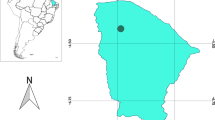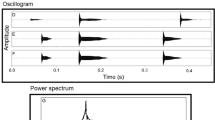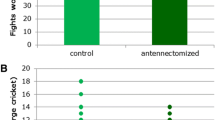Summary
This study examines the use of dominant frequency for assessment of fighting ability in Blanchard's cricket frog Acris crepitans blanchardi. Like most anurans, the dominant frequency of the call is negatively correlated with size. However, unlike many anurans, dominant frequency varies within individual males, providing a less reliable signal of size. Wrestling contests between male cricket frogs were differentially won by larger males. I thus tested the hypothesis that males use dominant frequency for assessment of an opponent's fighting ability. Males retreated from, or became satellites of, broadcasts of synthetic low frequency calls, simulating the calls of a large male. In contrast, males attacked broadcasts of synthetic high frequency calls, simulating the calls of a small male. The dominant frequency of the call therefore appears to contain information about size which males use to assess the fighting ability of opponents, despite the lower degree of reliability resulting from individual variation in the signal. Individual variation in dominant frequency arises partially as a consequence of active alteration of the signal in response to social competition. Males differentially lowered their dominant frequencies in response to lower frequency broadcasts, thus in response to larger opponents. Furthermore, the higher a male's dominant frequency relative to that of an opponent, the greater was the decrease in dominant frequency. These results suggest that smaller males may conditionally lower their dominant frequencies in order to sound larger to larger opponents, thereby inflating their apparent fighting ability. Two alternative hypotheses are discussed.
Similar content being viewed by others
References
Arak A (1983) Sexual selection by male-male competition in natterjack toad choruses. Nature 306:261–262
Bucher TL, Ryan MJ, Bartholomew GA (1982) Oxygen consumption during resting, calling, and nest building in the frog, Physalaemus pustulosus. Physiol Zool 55:10–22
Clutton-Brock TH, Albon SD (1979) The roaring of red deer and the evolution of honest advertisement. Behaviour 69:145–170
Davies NB, Halliday TR (1978) Deep croaks and fighting assessment in toads Bufo bufo. Nature 274:683–685
Dawkins R, Krebs JR (1978) Animal signals: information or manipulation? In: Krebs JR, Davies NB (eds) Behavioural ecology: an evolutionary approach. Blackwell Scientific Publications, Oxford, pp 282–309
Gardner R, Morris MR (1989) The evolution of bluffing in animal contents: an ESS approach. J Theor Biol 137:235–243
Howard RD (1978) The evolution of mating strategies is bullfrogs, Rana catesbeiana. Evolution 32:850–871
Kodric-Brown A (1977) Reproductive success and the evolution of breeding territories in pupfish (Cyprinodon). Evolution 31:750–766
Kodric-Brown A (1986) Satellites and sneakers: opportunistic male breeding tactics in pupfish (Cyprinodon pecoensis). Behav Ecol Sociobiol 19:425–432
Krebs JR, Dawkins R (1984) Animal signals: mind-reading and manipulation. In: Krebs JR, Davies NB (eds) Behavioural ecology: an evolutionary approach. Second edition. Blackwell Scientific Publications, Oxford, pp 380–402
Lopez PT, Narins PM, Lewis ER, Moore SW (1988) Acoustically induced call modification in the white-lipped frog, Leptodactylus albilabris. Anim Behav 36:1295–1308
Martin WF (1972) Evolution of vocalization in the genus Bufo. In: Blair WF (ed) Evolution in the genus Bufo. University of Texas Press, Austin, pp 279–309
Maynard Smith J (1982) Do animals convey information about their intentions? J Theor Biol 97:1–5
Maynard Smith J, Parker GA (1976) The logic of asymmetric contests. Anim Behav 24:159–175
Maynard Smith J, Price GR (1973) The logic of animal conflict. Nature 246:15–18
Parker GA (1974) Assessment strategy and the evolution of fighting behaviour. J Theor Biol 47:223–243
Perrill SA, Magier M (1988) Male mating behavior in Acris crepitans. Copeia 1988:245–248
Ramer JD, Jenssen TA, Hurst CJ (1983) Size-related variation in the advertisement call of Rana clamitans (Anura: Ranidae), and its effect on conspecific males. Copeia 1983:141–155
Riechert SE (1978) Games spiders play: behavioral variability in territorial disputes. Behav Ecol Sociobiol 3:135–162
Robertson JGM (1986a) Male territoriality, fighting and assessment of fighting ability in the Australian frog Uperoleia rugosa. Anim Behav 34:763–772
Robertson JGM (1986b) Female choice, male strategies and the role of vocalizations in the Australian frog Uperoleia rugosa. Anim Behav 34:773–784
Ryan MJ (1980) Female mate choice in a Neotropical frog. Science 209:523–525
Ryan MJ (1985) The tungara frog, a study in sexual selection and communication. University of Chicago Press, Chicago
Ryan MJ, Hews DK, Wagner WE Jr. Sexual selection an alleles that determine body size in the swordtail Xiphophorus nigrensis. Behav Ecol Sociobiol (in press)
Ryan MJ, Wilczynski W (1988) Coevolution of sender and receiver: effect on local mate preference in cricket frogs. Science 240:1786–1788
Sokal RR, Rohlf FJ (1981) Biometry. WH Freeman and Company, New York.
Steger R, Caldwell RL (1983) Intraspecific deception by bluffing: a defense strategy by newly molted stomatopods (Arthropoda: Crustacea). Science 221:558–560
Sullivan BK (1982) Significance of size, temperature and call attributes to sexual selection in Bufo woodhousei australis. J Herpetol 16:103–106
Sullivan BK (1983) Sexual selection in the Great Plains toad (Bufo cognatus). Behaviour 84:258–264
Sullivan BK, Wagner WE Jr (1988) Variation in advertisement and release calls, and social influences on calling behavior in the Gulf Coast toad (Bufo valliceps). Copeia 1988:1016–1022
Taigen TL, Wells KD (1985) Energetics of vocalization by an anuran amphibian (Hyla versicolor). J Comp Physiol B 155:163–170
Turner GF, Huntingford FA (1986) A problem for game theory analysis: assessment and intention in male mouthbrooder contests. Anim Behav 34:961–970
Wagner WE Jr. (1989a) Social correlates of variation in male calling behavior in Blanchard's cricket frog, Acris crepitans blanchardi. Ethology, in press
Wagner WE Jr. (1989b) Graded aggressive signals in Blanchard's cricket frog: vocal responses to opponent proximity and size. Anim Behav, in press
Wiley RH (1983) The evolution of communication: information and manipulation. In: Halliday TR, Slater PJB (eds) Animal behaviour Volume 2. Communication. WH Freeman and Company, New York, pp 156–189
Zahavi A (1977) Reliability in communication systems and the evolution of altruism. In: Stonehouse B, Perrins CM (eds) Evolutionary ecology. Macmillan, London, pp 253–259
Zweifel RG (1968) Effects of temperature, body size, and hybridization on mating calls of toads Bufo a. americanus and Bufo woodhoussii fowleri. Copeia 1968:269–285
Author information
Authors and Affiliations
Rights and permissions
About this article
Cite this article
Wagner, W.E. Fighting, assessment, and frequency alteration in Blanchard's cricket frog. Behav Ecol Sociobiol 25, 429–436 (1989). https://doi.org/10.1007/BF00300189
Received:
Accepted:
Issue Date:
DOI: https://doi.org/10.1007/BF00300189




